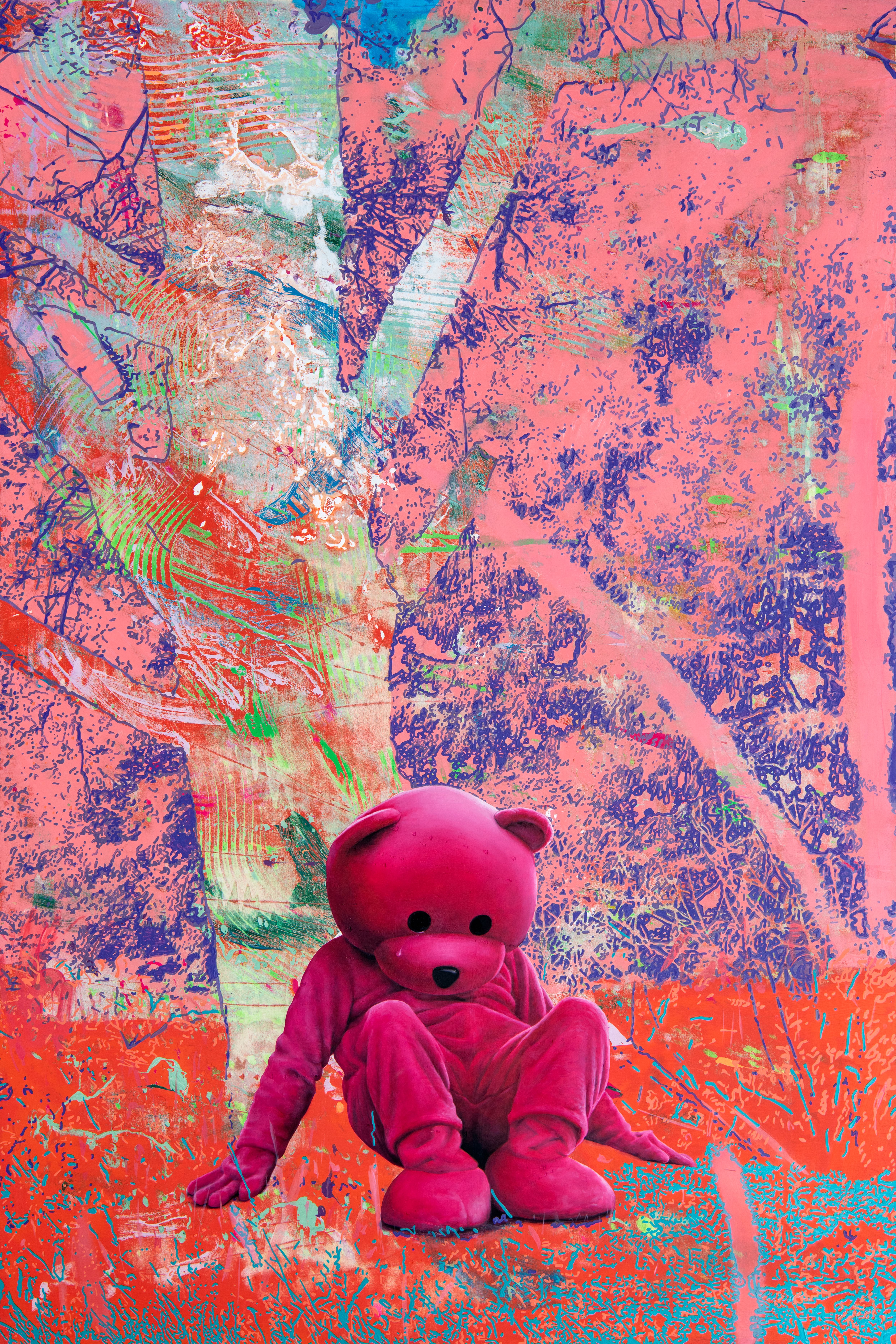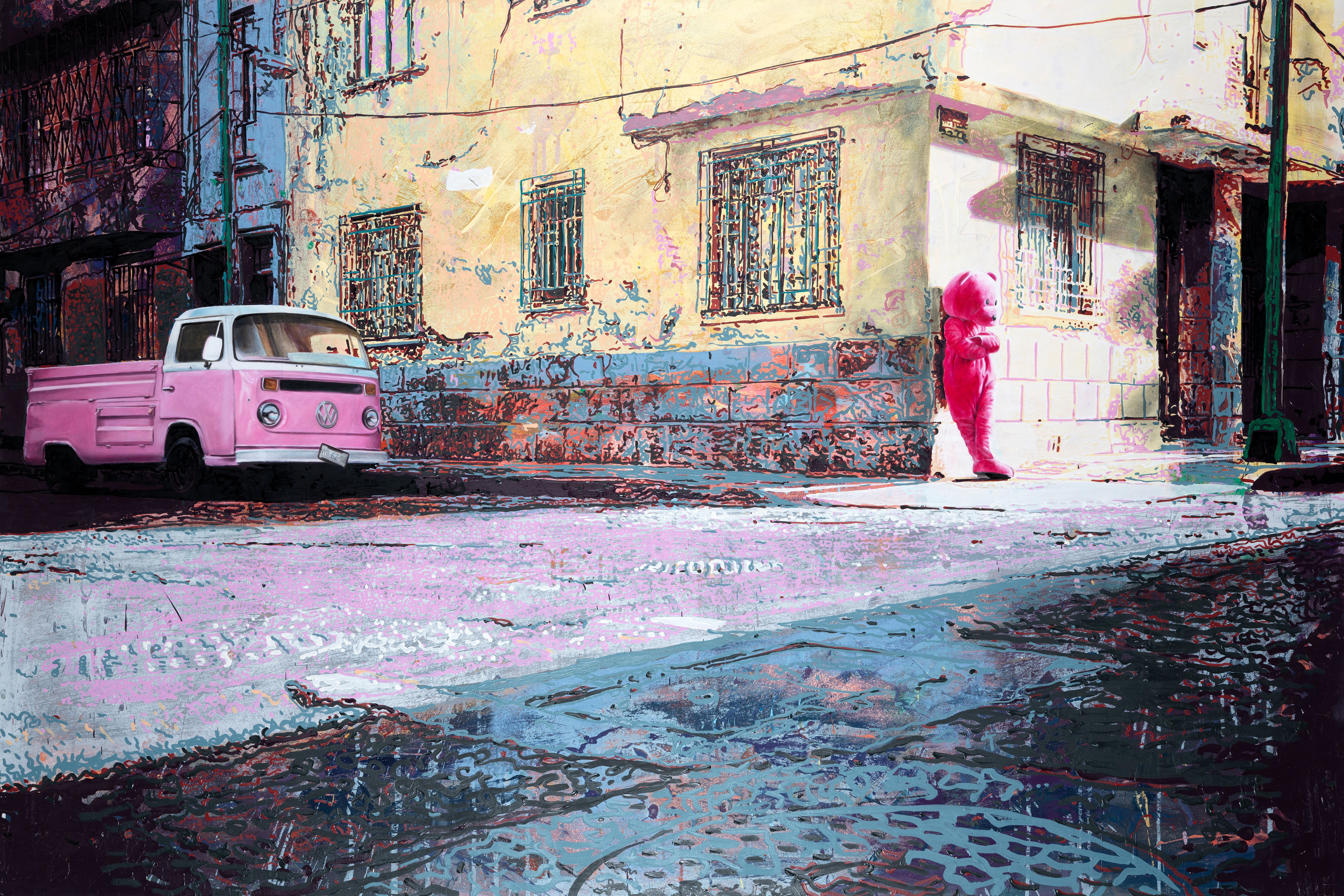
There are few in the world of contemporary art who are not aware of Pink Bear, the iconic brainchild of artist LUAP (Paul Robinson), who is often presented as a shocking pink solitary figure in dark, remote landscapes, meticulously rendered in oversized realist paintings. These huge canvases are based on high-resolution images of Robinson himself wearing the anonymous bear suit in some of the furthest flung corners of the globe, and the apparent loneliness of the figure is far from merely aesthetic. Pink Bear has profound roots, and was born from Robinson’s journey into childhood memories during CBT therapy sessions he undertook to overcome dissociative depression. His latest iteration of the bear’s journey, The Pink Bear Pavilion, unpacks these origins in a landmark collaboration with the University of Europe for Applied Sciences (UE). The four-metre-tall, walk-in installation embodies a fusion of art, design and cutting-edge technology, and acts as a significant figurehead to mark a major component of this ongoing project – namely, the UE’s granting of 17 'LUAP Pink Bear Scholarships' (the overall fund for which is a staggering €250,000). The Pink Bear Pavilion thereby expands on the artist’s continued exploration of the inner landscape of his creation, delving into many universal facets of humanity, such as mental well being, environmental awareness and inter-personal relationships, but also seeks to facilitate similar creative journeys. Here, the artist reflects upon the genesis of the project, and gives House Collective Journal a candid breakdown of the healing power of art.
What set you out on the path of the artist in life? Can you recall anything in your formative years that was fundamental in setting you on that path?
I’m lucky to say I excelled in all subjects and sports from a young age, consistently at the top of my class and school, so I believe I could have been anything. But art always spoke to me the loudest. I was somewhat of an overachiever but was often questioned by my teachers during self-assessments about why I was so self-deprecating. They often asked me to rewrite them because they always read, “I must try harder” despite having achieved the highest marks in the school. I was a pushy parent to myself. Despite my success, I don’t remember being very well liked—it wasn’t that I was disliked, but I never felt like I fitted in. Art and creativity, however, were different. They resonated with everyone in my class and helped me to make friends. This connection likely influenced my decision to pursue this path, as I recognized the power of art to forge connections even from a young age. There was also something deeper. Creating things felt so natural and fundamental to me, and I always wanted to push further and create bigger works even at a young age. When I wasn’t creating something new, experimenting, or looking at the world around me, I just felt wrong.

What does the symbol of the Pink Bear represent to you? Could you unpack the memory of the bear and the conceptual genesis of the work for me?
It came from loneliness. At the heart of my artistic practice is "The Pink Bear," a cherished remnant of my childhood. Through cognitive behavioural therapy (CBT), I resurrected this figure, transforming it into a vessel for journeys of revelation and exploration. "The Pink Bear" embodies a spectrum of human experiences, symbolising aspirations and anxieties. An enigmatic personality, it navigates the surreal, the imagined, and the tangible. Body language is central to my work, with the bear's deliberately expressionless face serving as the focal point. Using various poses and props, I enrich my art's storytelling aspect, weaving intricate narratives through the bear's demeanor and gestures. It all started with loneliness, leading to a series called Lone Soldiers (2008-2011). This series began with a single tree photographed in diverse environments, superimposed on wallpaper evoking my childhood. It reflected my mood—drifting, guarded, isolated—a solitary tree in a forest surrounded by other trees. Many of us feel like isolated trees in a crowded forest.Disconnected from those around me, I struggled to communicate. How could I, when I was even disconnected from myself? They called it dissociative disorder. As life happened and love came and went, my depression deepened, along with the vast disconnect. CBT became my lifeline, a bridge to connection.
What shape did the therapy take symbolically, how did it work?
With my therapist, we explored trees as I envisioned them. She asked me to draw a tree to represent my emotions or people in my life. In another session, I visualised and drew the tree I wanted to be. The tree I was and the tree I aspired to be were polar opposites. Shedding my negativity and embracing positivity, my branches spread, and my leaves sprouted. I grew a bridge to connection, enabled by nature. Enter The Pink Bear. Like the wallpaper, I invoked the carefree, tender childhood memory of a picture with my mum, dad, and brother, with a giant neon pink bear stoically among us. The memory brings a smile to my face and takes me to a place of love and safety. When I felt uncomfortable in my own skin, I would turn to the bear. The bear represents the feeling of not accepting yourself in front of others, internalising it all, and disconnecting to be someone you're not. The Pink Bear became the vehicle with which I crossed the bridge to the connection nature had gifted me.

I like the anonymity of The Bear – how much of your work is tied to your identity?
By opting against giving the Pink Bear a fixed facial expression, I aimed to avoid imposing a specific mood onto the images. Instead, my intention was for the bear to act as a mirror, reflecting the personal emotions of the viewer and fostering a deeper connection with the artwork. This neutral expression allows viewers to project their own feelings and interpretations onto the piece, enriching their experience and allowing for a more nuanced engagement with the work. The Pink Bear emerged from the recesses of my childhood memories, surfacing during my exploration of CBT. Initially, I viewed the Pink Bear as an alter ego, a protective second skin worn to events, a mask concealing my true self beneath a veneer of a happy memory. Relying on this character to navigate the world only fuelled negative coping mechanisms, reinforcing the belief that I didn't quite fit in. Over time, the Pink Bear underwent a transformative journey, evolving into a symbol of positivity and recovery. No longer a mask or a creature in hiding, it transformed into a beacon of strength and resilience—qualities I aimed to embody in my self-improvement journey. Today, the Pink Bear symbolises hope and has played a pivotal role in my personal growth.
Where did the idea for the Pink Bear Pavilion come from?
The idea for the Pink Bear Pavilion originated from a moment of inspiration while I was sitting at my worktable, working on maquettes for smaller sculptures. One of these was a 12-inch costume for an action figure, standing next to my full-sized costume head. Suddenly, the thought struck me: "Wow, what would it look like if it were possible to scale this up to human-sized proportions?" This spark of imagination led to the concept of creating an immersive space where people could interact with The Pink Bear and delve deeper into the themes of my work. The pavilion is a physical manifestation of the journey The Pink Bear represents—a place for introspection, connection, and transformation. From a tiny four-inch miniature sculpture, I was able to scale up to what ultimately became the pavilion, a four-metre-tall, walk-in installation.

Can you talk me through its genesis and the exhibits inside?
I have been developing ideas for and working on the design and fabrication for The Pink Bear Pavilion for two years. It is my largest sculpture to date (so far!). Part of the work was how to get it funded, but ultimately I was able to have it commissioned by the University of Europe for Applied Sciences (UE) and we unveiled it recently at the Altonaler Balkon, as part of the altonale Festival in Hamburg. It was an amazing process to create the sculpture also in collaboration with Nagami, CH2O, and Exarchitects, and it is crafted from 2500 kg of recycled plastic, brought to life with the precision of eight large robotic arms. I am strongly committed to sustainability, so the pavilion's construction champions eco-consciousness through the utilization of recycled materials, FSC-certified timber and cutting-edge 3D printing technology. Inside the pavilion, the central exhibit is titled Introspection. This work delves into the theme of self-reflection, juxtaposing the exterior of a bear head with the experience of looking in a mirror. While we observe our outward appearance, it is our inner voice that engages in conversation. This dual perspective—seeing the exterior while connecting with the interior—captures the essence of introspection. The exhibit embodies this duality, representing how we navigate our inner and outer selves simultaneously. Through introspection, we can feel better about ourselves. It all begins within our own unique minds. Alongside Introspection, the Pink Bear Pavilion serves as a dynamic canvas, showcasing projects by UE students. This symbiotic presentation not only echoes the ethos of the Pink Bear but also underscores the importance of inclusion and diversity as central themes, with visitors invited to forge connections with one another while exploring artworks that celebrate diversity, foster bonds, and promote inclusion.

What are your hopes for the pavilion?
Initially conceived as a sanctuary for LUAP, the bear has evolved into a symbol of comfort for all. The pavilion’s structure has grown from miniature to monumental, originally sculpted in plasticine before being 3D-scanned and scaled. What began as a mere 6cm figure has now become a four-metre-tall immersive experience. Stepping into the bear head is akin to entering the bear's mind—a sanctuary, a refuge. Visitors to the large-scale Pink Bear Pavilion are invited not only into a profound immersion into my artistic world but also to experience art from the perspective of a child, transporting them to a place of wide-eyed openness. I hope the pavilion will offer a space for introspection, connection, and transformation, where people can reflect on their own emotions and experiences, feel understood, and find a sense of comfort and joy. My work aims to encourage viewers to reflect on their own emotions and experiences, to see parts of themselves in the neutral expression of The Pink Bear, and to feel understood and less isolated. I hope to foster a deeper emotional connection and inspire conversations about identity, loneliness, and personal growth.
Find out more about The Pink Bear Pavillion here
Images (top to bottom): The Absence of Presence, oil and acrylic on ply, 2021: I Don't Alway Recognise Myself, oil and acrylic on ply, 2021; Searching Through My Memories, oil and acrylic on canvas, 2021, Pink Clouds And Silver Linings; Time Can Escape You. All images courtesy of the artist.